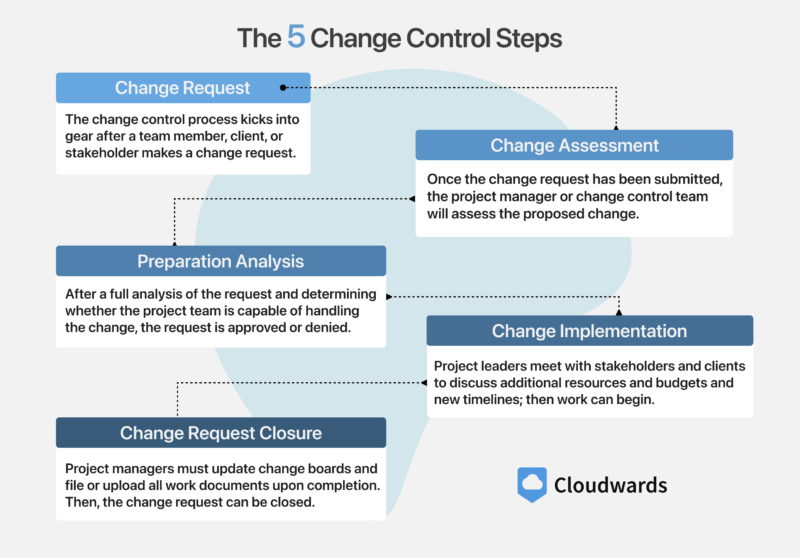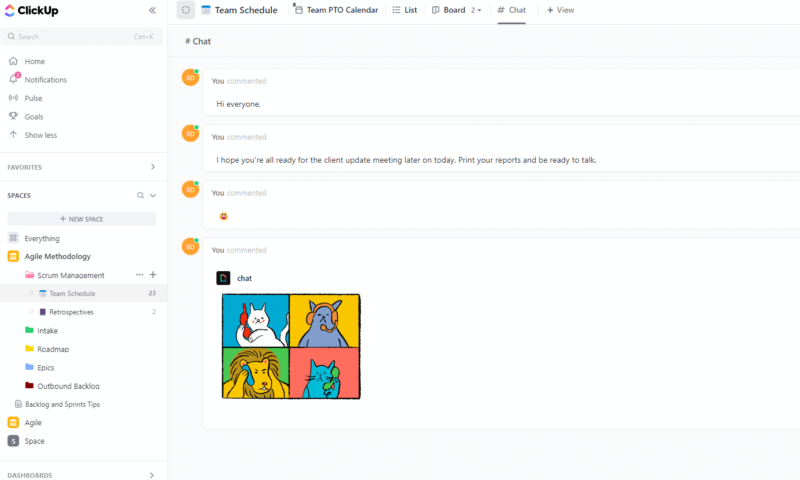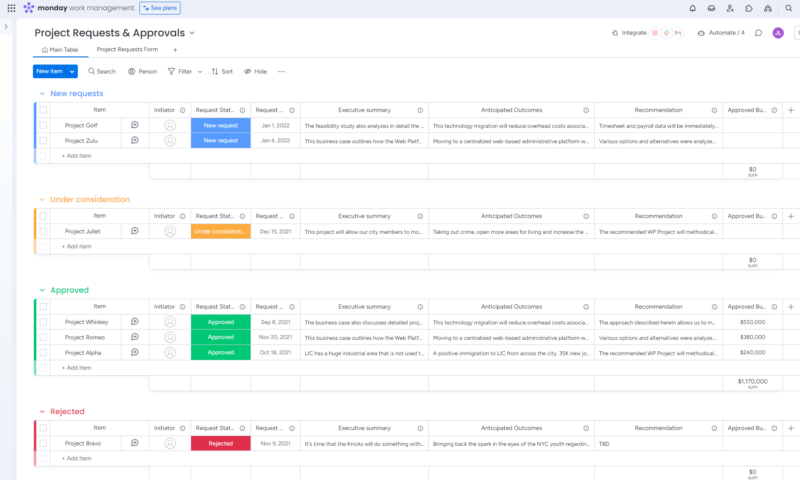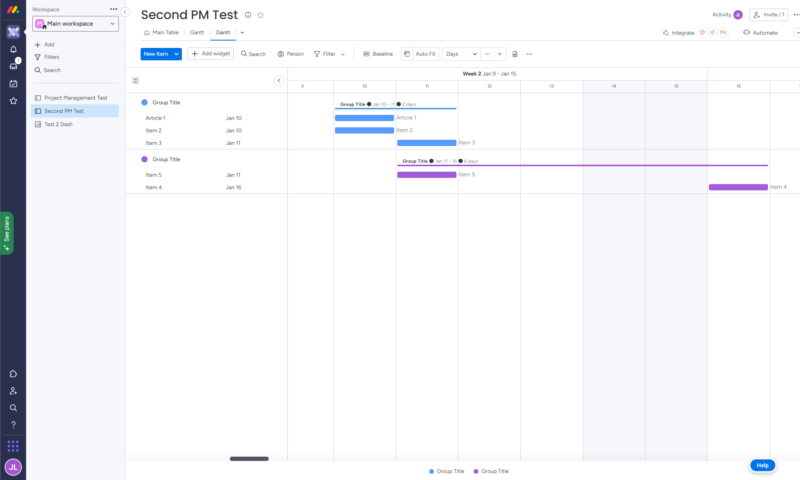Making too many changes to an ongoing project can wreak havoc on a project’s deliverables. Allowing changes to a project’s scope can lead to missed deadlines, overworked employees, blown budgets and poor resource management. Fortunately, it’s easy to adopt change control in project management — it can be implemented efficiently with some of the best project management software.
In this guide, we’ll explain what change control is and how it can benefit your organization. We’ll list the five change control steps that every project manager needs to know, and we’ll also cover how you can improve your workplace by adopting the process. We know you’re eager to learn, so let’s get started.
What Is Change Control?
Change control is a method for processing change requests from clients and stakeholders that alter a project’s scope (plan). All project managers have their own ways of handling change requests. Still, these requests are generally submitted via a form. After the request is evaluated to determine its impact on timelines, resources and budgets, it will be approved or denied.
The idea behind this change process is to prevent the project’s aspects from being changed for no good reason. This review process ensures that all changes are made for the greater good. It also helps keep the entire project on budget and on time, thus avoiding scope creep.
Is Change Control the Same as Change Management?
While change control and change management sound the same, they’re actually different processes that shouldn’t be used interchangeably. Below, we’ll quickly explain their differences.
- Change control: Change control is a structured process for approving requests related to the original project plan. Without change control, projects could spiral out of control.
- Change management: Change management deals with teams that resist change in the workplace. Change managers help ease the process of implementing new technology, systems or procedures. If you’re interested in becoming a change manager, check out our guide to the best change management certifications.
The 5 Change Control Steps
Like most processes, change control has numerous steps that must be followed for it to succeed. Below, we’ll explain the “whys” and “hows” of the five key elements of change control so you can better understand them.

When Is It Necessary to Use Change Control?
It’s necessary to use change control when managing a project with tight budgets or limited resources, or when a team is getting used to new processes and systems. Practice change control when any of the following conditions apply:
- You have a small budget: If you’re working with limited funds, the last thing you want is to add more work that you can’t afford. If the client or stakeholders don’t want to pony up extra cash, insist on using change controls. If you don’t, you’ll likely run into scope creep.
- There are tight deadlines: If the requesting party is unwilling to extend deadlines to accommodate the extra work and you accept every request, you’ll probably experience scope creep. Tell everyone that it’s change control or bust.
- You don’t see the benefit: If a change request from a client, stakeholder or team member doesn’t make sense, you can use the change control analysis process to show them why. As a project manager, you can’t be afraid to say “no.”
- You’re working with new clients: When working with new clients in situations where levels of trust haven’t been built yet, insist on change control management. This will protect your company and those you’re working with, too.
Elements of the Change Control Process
To implement change control effectively in your workplace, you’ll need to familiarize yourself with some key elements that will help you along the way. We’ll share a brief description of each element below.
Change Control Board
A change control board is a central hub that all team members, clients and stakeholders can interact with during the change control process. A board lists the requested change, its potential impact, the proposed budgets and timelines, and any planning notes should the request be approved.
Change Request Forms
A change request form — either a physical paper form or a digital variant — should be readily available so that requests can be made. The form doesn’t have to be complex; it just needs to list the proposed change, explain its necessity and expected impact, and outline the potential budget and timeline changes.
Procurement Documents
If a change request is approved, you’ll see an influx of procurement documents. These documents can include contracts for temporary employees, statements for resources, bills for goods and services, and more. You must be prepared to handle all the paperwork, so ensure that your project management software has a solid document management system (DMS).
Benefits of Change Control in Project Management
Extra checks and balances in project management can create more work, but the benefits of diligence far outweigh the cons of carelessness. Below are some of the benefits of change control.
Increased Communication
Practicing a systematic approach like change control and implementing communication channels can enhance discussions between project managers, project teams, stakeholders and clients. Free-flowing communication makes it easier to manage change requests, deny unnecessary changes and periodically review proposed changes.
Enhanced Collaboration
With clear communication comes better collaboration. When all team members, project stakeholders and clients are on the same page, moving everyone in the same direction becomes easier.

mind-map tools that make collaboration easy.
With everyone in sync, the project’s schedule is protected and project deliverables should arrive on time. Morale will likely increase, and budgets are more likely to be met. If you need project management software that will make real-time collaboration easy, check out ClickUp. You can get more information about it in our ClickUp review.
Improved Financial Control
A big business case for change control is improved financial control. Using a changelog to analyze requests, take a deep dive into a potential change, determine new risks and make a final decision can significantly impact your bottom line. Being methodical and making informed decisions instead of just approving every request will help protect everyone’s money.
Increased Productivity
When every team member is heading in the same direction and knows what’s expected of them, productivity will increase. If you need software that can help track your team’s productivity and can integrate with other platforms, you should take a closer look at Zoho Projects. Our Zoho Projects review has more details.
Change Control Process Example
In this section, we’ll take a quick look at a change control process. Every company will have a process that’s tailored to its needs, but each process should include at least the steps we list here:
- Receive the change request: Receive a completed change request form that a team member, stakeholder or client has filled out.
- Analyze the request: Enter the request details into a change board and assess the information provided. If you think the change is warranted after performing the initial assessment, get ready to complete a preparation analysis.
- Complete a preparation analysis: During the preparation analysis, the project manager or change request team will determine if the change will add value to the deliverable. They will also decide whether they have the resources and budgets to support it and whether the current team can handle the extra work. When the analysis is complete, the request will be approved or denied.
- Complete the work: If the request is approved, have your team complete the work on the requested change.
- Close the request: When the work is finished and it has been approved by the client or stakeholders, file any documents and close the request.
Tips for a Smooth Change Control Process
If you’ve decided to start using change control in your next project, be sure to follow these tips.
Use Project Management Software
Software like monday.com, ClickUp, Zoho Projects and others can help you receive change request forms, keep detailed changelogs, monitor finances and resources, keep a task list and much more. If you run a small business and want to implement change controls, read our roundup of the best project management software for small teams and businesses.
Champion Open Communication
A surefire way to get ahead in anything is to champion communication. If you’re a remote team, utilize tools like Slack, Zoom and Google Meet, or ensure that your project management software has solid chat and commenting systems. Encourage team members to speak up, and let stakeholders and clients know that they can come to you with questions and concerns.
Identify Risks
During the preparation analysis stage, make sure you take the time to list the potential risks and issues that may arise from taking on extra work. By using risk assessment templates, you can notate risks and generate plans to deal with problems should they occur. To learn more about risks, check out our risks vs issues guide.
Final Thoughts
Project leaders should insist on implementing change control policies to ensure that projects stay on budget and on time, allowing you to deliver the best product possible. The change control process can determine if a change will add value to a product, if it’s financially viable and if the project deadline must be extended.
Not having a process like this in place can lead to dire consequences. Approving every request without hesitation will lead to overworked employees, missed deadlines, blown budgets and lower-quality products. As you can see, you really should insist on using change control policies.
Have you implemented a change control process in your workplace? What project management software do you use to help you manage change requests? Do you have any change control tips you’d like to share? Let us know in the comments. Thanks for reading.
FAQ: Change Control System
-
Change controls can be used to analyze change requests for products under development, software installations, requests for more software features, updated deadlines and budgets, and more.
-
The main stages in the project change control process are receiving a change request, analyzing the request, completing a preparation analysis, completing the work and closing the request.
-
Change management is the process of helping teams accept change in the workplace. Change managers help individuals prepare for new software, policies, procedures and more.
-
The five project controls that help managers determine a project’s scope include scheduling, resources, risk management, change and performance.
{“@context”:”https:\/\/schema.org”,”@type”:”FAQPage”,”mainEntity”:[{“@type”:”Question”,”name”:”What Are Examples of Change Control?”,”acceptedAnswer”:{“@type”:”Answer”,”text”:”
Change controls can be used to analyze change requests for products under development, software installations, requests for more software features, updated deadlines and budgets, and more.\n”}},{“@type”:”Question”,”name”:”What Are the Main Stages in a Project Change Control Process? “,”acceptedAnswer”:{“@type”:”Answer”,”text”:”
The main stages in the project change control process are receiving a change request, analyzing the request, completing a preparation analysis, completing the work and closing the request.\n”}},{“@type”:”Question”,”name”:”What Is Change Management Control? “,”acceptedAnswer”:{“@type”:”Answer”,”text”:”
Change management is the process of helping teams accept change in the workplace. Change managers help individuals prepare for new software, policies, procedures and more.\n”}},{“@type”:”Question”,”name”:”What Are the 5 Project Controls? “,”acceptedAnswer”:{“@type”:”Answer”,”text”:”
The five project controls that help managers determine a project\u2019s scope include scheduling, resources, risk management, change and performance.\n”}}]}
The post Change Control in Project Management: Process, Steps, Benefits, Examples & More in 2024 appeared first on Cloudwards.



